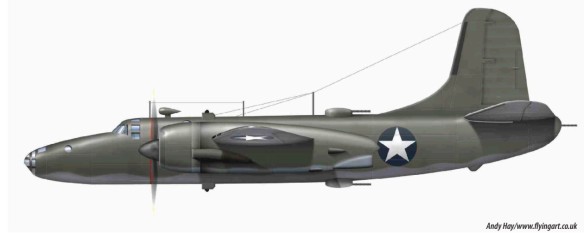
DEVELOPMENT
On November 15, 1939, the USAAC gave NAA a contract to build a single prototype twin-engine high-altitude medium bomber. This contract for the latest aircraft, designated as the XB-28 (NA-63), came only two months after work began on the B-25. The XB-28 would be a revolutionary aircraft which went way beyond the remit delivered in 1939 for a medium bomber aircraft.
The expected benefit of bombing from higher altitudes was a measure of safety from ground based artillery, and from fighters incapable of similar altitudes. However, high-altitude bombing was problematic before the invention of modern guided (or “smart”) bombs. The ability to destroy small targets like bridges, dams, radio transmitters, and electrical sub stations while avoiding collateral damage was especially vexing. It was said the famed Norden bombsight could “drop a bomb in a barrel from 18,000 feet,” an assertion that may have had a placebo effect on any crewmen harboring qualms of innocent civilian deaths caused by bombing errors. However, the phrase “high-altitude precision aerial bombardment” is oxymoronic. While the Norden bombsight was an invaluable aiming tool, the combination of altitude, clouds, human error, and winds all too frequently combined to yield unfavorable margins for error that could translate to civilian deaths.
DESIGN
The XB-28 had a cylindrical fuselage fitted with a pressurised forward section, which contained all five crew. It could maintain a pressure equivalent of 8,000ft up to an altitude of 30,000ft. The aircraft’s twin Pratt & Whitney R-2800 engines with General Electric superchargers could push the bomber up to 35,000ft. The bomb bay was designed to carry up to 4,000lb, made up of 20 100lb, eight 300lb, two 1,000lb or two 2,000lb bombs or alternatively a large, long range ferry tank.
Defensive armament was far heavier than the B-25, made up of a pair of 0.5in Browning machine-guns in a trio of remotely controlled, power-operated turrets which were patented by NAA. The gunners who controlled these weapons each had a periscope and scanning lenses for spotting and tracking the enemy fighter.
SERVICE
On April 24, 1942, the prototype XB-28, 40-3056, was first flown from Mines Field in the hands of Ed Virgin and Joe Barton. The XB-28 was found to be an excellent performer and it was not long before the aircraft was being operated with a full crew on board, before being taken over by the USAAF and flown to Wright Field where further flight testing was carried out.
Ordered on January 12, 1940, a second much lighter machine, designated as the XB-28A (NA-67), and serialled 40-3058 was rolled out at Mines Field in early 1943. The XB-28A was designed as a reconnaissance aircraft and its main differences from the original machine were the fitment of General Electric turrets and a photo-mapping installation of four cameras behind the bomb bay. On April 24, 1943, Virgin and Barton flew the XB-28A for the first time; exactly one year after the XB-28.
Several months of flight testing for the XB-28A followed, culminating on August 4, 1943 when Bob Chilton and engineer Roy Ferren were tasked with carrying out several manoeuvres and calibrations along the California coast. Whilst gaining some speed in a shallow dive, the XB-28A began to suffer from a violent tail shake followed by an uncontrollable roll to port. Unable to control the aircraft any further, both crew donned their parachutes and bailed out; Ferren noticing as he left the aircraft that the fin was bent at an angle of 45°. Both Chilton and Ferren were later safely recovered from the Pacific Ocean.
By this time, the B-28 had been prepared for full NAA production under the designation NA-89 but the B-25 had more than proved itself and the USAAF were in no mood to stop its production. The Martin B-26 was already carrying a similar bomb load at the same speed, admittedly not at high-altitude and, like the B-25, it was comfortably settled into high production. By late 1943, the USAAF had gone off the idea of high-altitude bombing, resulting in the cancellation of the B-28.
Performance was impressive enough for the Army to order a second prototype built as a high-altitude photo reconnaissance aircraft. This plane was designated XB-28A but never progressed past the prototype phase.
Although the XB-28 was a successful design, the aircraft never went into production. One reason for this was high-altitude bombing was too susceptible to errors caused by wind, cloud cover, etc., especially in the Pacific Theater of Operations. Another was the increasing effectiveness of medium bombers at low and medium levels along with improved tactics. Finally, the performance gains were not considered great enough to interrupt production of proven combat models.
Sadly, the surviving XB-28 was scrapped.
Specifications:
Armament: Six .50-cal. machine guns and 4,000 lbs. of bombs
Engines: Two Pratt & Whitney R-2800-27 Double Wasp radials of 2,000 hp each (takeoff power)
Maximum speed: 372 mph
Cruising speed: 255 mph
Range: 2,040 miles
Service ceiling: 33,500 ft.
Span: 72 ft. 7 in.
Length: 56 ft. 5 in.
Height: 22 ft. 0 in.
Weight: 35,740 lbs. (gross)
Crew: Five
Serial numbers: 40-3056 (XB-28) and 40-3058 (XB-28A)